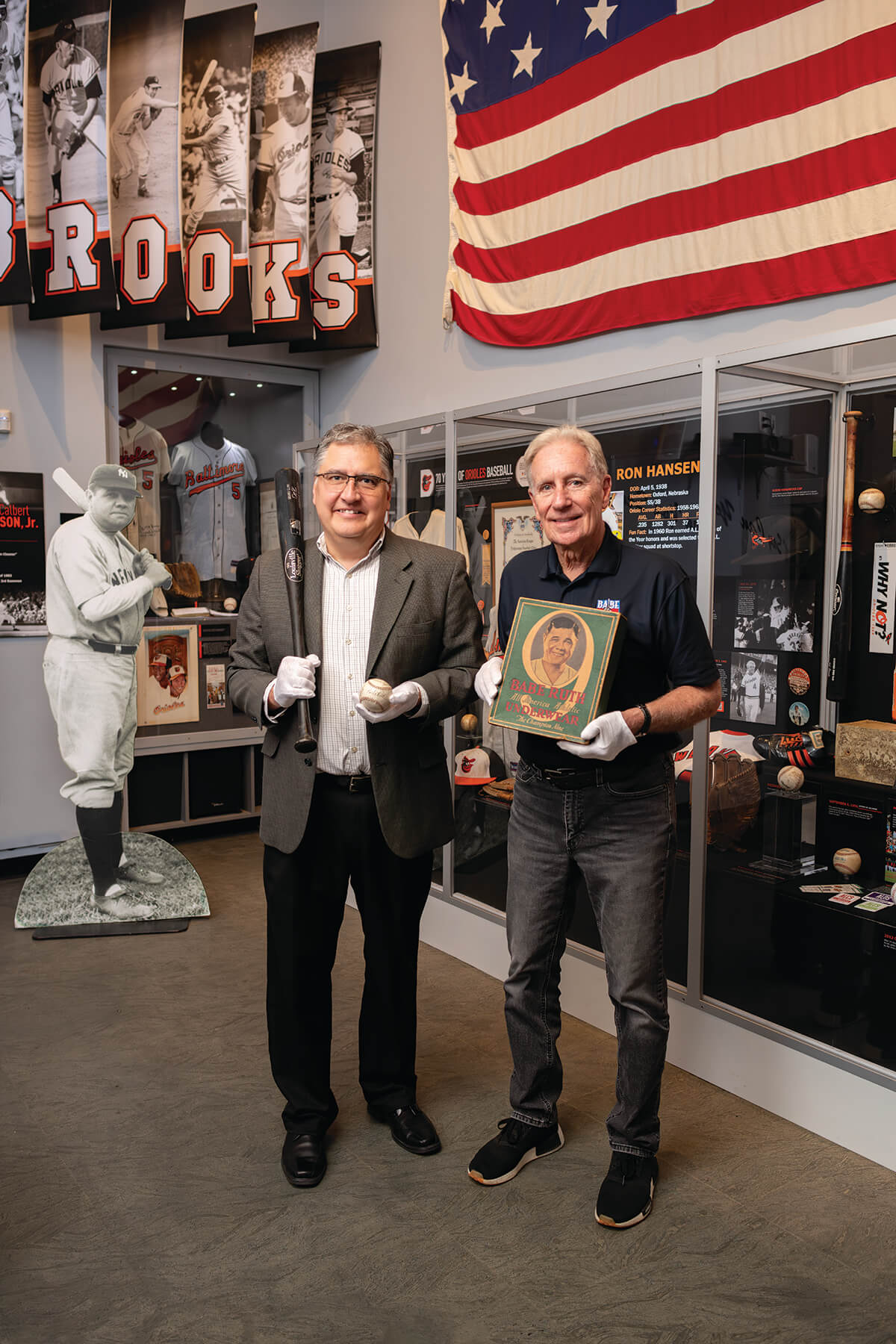News & Community
As the Babe Ruth Birthplace & Museum Turns 50, It’s Looking to Grow Again
A skinny three-story brick rowhouse can only showcase so much—especially when the independent nonprofit that operates it has grown to include duties as the Orioles’ official museum, the Colts’ archives, and essentially a repository of all Maryland sports.

A slice of Baltimore sports heaven is found, for now, in the climate-controlled basement of 216 Emory Street in Ridgley’s Delight. Two blocks from Oriole Park at Camden Yards, and two floors below where Babe Ruth was born almost 130 years ago, neatly arranged on shelves below UV-filtered light are dozens of artifacts fit for a spectacular episode of Antiques Roadshow. Or their own museum, in addition to the one already upstairs.
“This is Johnny Unitas’ first contract—$7,000, 1956,” says Michael Gibbons, director emeritus of the Babe Ruth Birthplace & Museum, before pulling another file: hand-written lyrics to “Thank God I’m a Country Boy,” penciled in cursive by John Denver’s fiddle player, John Sommers, on yellow legal paper. Inevitably, there’s also one of Ruth’s 714 home-run balls sitting in a box on a table.
“Many of these things have stories,” says Gibbons, pictured right, above, and he’d like you to know them.
The origin story of Ruth—the Great Bambino, one-time Oriole who became a Yankees legend, Hall-of-Famer, and American cultural icon in the early 20th century—is exhibited above ground here, as it has been for 50 years.
Since this “national shrine” opened in 1974, thanks to a campaign to save the building and those around it from demolition, hundreds of thousands of visitors have seen the centerpiece second-floor bedroom, where, on Feb. 6, 1895, Katherine Ruth delivered baby George Herman, later known as “Babe.” The living museum also includes pictures of the Ruth family, rare Ruth baseball cards, and items from his childhood, like a bat he likely used as a teenager.
But a skinny three-story brick rowhouse is only large enough to showcase so much, especially when the independent nonprofit that operates it has grown over the decades to include duties as the Orioles’ official museum, the Colts’ archives, and essentially a repository of all Maryland sports that was, until 2015, largely displayed in the Ruth Birthplace Foundation’s Sports Legends Museum next to Camden Yards. When that closed, renovations expanded the shrine’s original footprint to accommodate myriad artifacts.
“A LITTLE WOULD GO A LONG WAY TO BRING BALTIMORE SPORTS GLORY INTO THE DAYLIGHT.”
You can find the hymnal that Ruth scribbled in as a pro-claimed “incorrigible” boy at St. Mary’s Industrial School. “George H. Ruth, world’s worst singer—world’s best pitcher,” reads his first known autograph. The Colts’ Super Bowl V and the Orioles’ 1983 World Series trophies are also featured. But plenty of other priceless items are in storage, like Maryland men’s basketball coach Gary Williams’ NCAA title-game suit, and an orange Cal Ripken Sr. jersey with pockets sewn in the chest to hold packs of cigarettes.
“Our mission is to get this collection on display,” says Gibbons.
He and current executive director Shawn Herne, who helped launch the Legends Museum in 2005, consider this golden milestone as an opportunity to spread the word.
“Babe Ruth’s birthplace will be here,” says Herne, pictured left, but they’re seeking additional physical space to share the history, all while attracting at least 25,000 visitors annually at $15 per adult and $7 a child—their primary revenue source.
As part of the museum’s anniversary celebrations, Emory Street was just dubbed “Babe Ruth Way.” Of course, an Orioles team winning more games helps draw in bigger crowds. In the years ahead, so could part of the $1.2 billion in state funding allocated to redevelop the nearby stadiums.
In late July, Orioles owner David Rubenstein, a noted history buff, toured Ruth’s birthplace—basement included. “We’re hopeful that as he develops a plan, he thinks of us,” says Gibbons. “Maybe we can help a little bit.”
And a little would go a long way to bring the entirety of Baltimore sports glory into the daylight, and keep Babe’s hometown legacy alive and well.